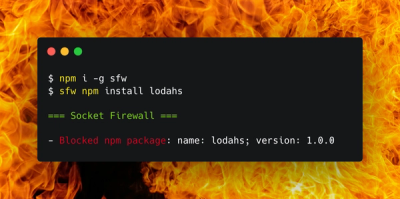
Security News
Package Maintainers Call for Improvements to GitHub’s New npm Security Plan
Maintainers back GitHub’s npm security overhaul but raise concerns about CI/CD workflows, enterprise support, and token management.
@appsocially/schedulerly-client
Advanced tools
To install the latest version of schedulerly-client
yarn add @appsocially/schedulerly-client
This package includes 2 clients for admin and user access. Both will have almost the same API for managing slots. The differences are:
admin will have full permission access to any user/calendar within the app, and requires a secret admin api key to be able to access the REST API. This client will also have special API to allow single user access by provide a custom login token for user. While this can be much more powerful with full access permission, it can be slow in some operation (latency of seconds).user will requires a custom token generated by the admin client (once), and will have limited access. They can only write to their own slots and calendar, and will have limited read permission on other's slots and calendars. While have less permission, this client can be faster than using just admin client (latency of hundreds milliseconds).For better security and performance reason, a flavor of mixing both these 2 clients often is the recommended way to implement.
Most application will requires at least the custom token end-point for user client access, this will describe the minimal setup to be able to do just that.
Admin ClientThis sample is using firebase functions as endpoint.
appToken: (Required) Secret app token for admin access.endPoint: (Required) Select which stage the client should connect to. There're 3 endpoints:
https://asia-northeast1-schedulerly-dev.cloudfunctions.net/apihttps://asia-northeast1-schedulerly-stage.cloudfunctions.net/apihttps://asia-northeast1-schedulerly-prod.cloudfunctions.net/apiconst schedulerly = require('@appsocially/schedulerly-client')
const functions = require('firebase-functions')
const endPoint = functions.config().schedulerly.baseurl
const appToken = functions.config().schedulerly.app_token
module.exports.schedulerlyService = schedulerly.admin.client({
appToken,
endPoint
})
/USERS/{ownerId} firestore path. We can use firestore trigger to also create an user on schedulerly.const userPath = '/USERS/{ownerId}'
module.exports.onUserCreate = functions
.firestore
.document(userPath)
.onCreate(async (snap, context) => {
let result = await schedulerlyService.createUser({})
console.log('Created user', result)
const { userId } = result
// Save the userId for token generator
saveSchedulerlyUserId(context.params.ownerId, userId)
})
user client can retrieve a token for client-side operations.// We have initialized this service in step 1
const { schedulerlyService } = require('../utils/schedulerly')
const functions = require('firebase-functions')
exports.generateSchedulerlyToken = functions
.region(ourRegion)
.https
.onCall((_, { auth }) => {
// We would expect that the current user has already logged in into the
// application, so that we know their identity already. We then can
// figure out this user's schedulerly ID
const schedulerlyUserId = getSchedulerlyUserId(auth.uid)
return schedulerlyService.generateToken({ userId: `${schedulerlyUserId}` })
})
User ClientThese examples are written with vuejs.
import { SchedulerlyClient } from '@appsocially/schedulerly-client'
export const schedulerlyClient = new SchedulerlyClient({
// The stage parameter would be for choosing which stage the client is using.
// The `admin` and `user` clients must be using the same stage.
stage: process.env.VUE_APP_STAGE
})
If the user has already logged in into the application. This user can be authenticated with a custom token and will have permission to write into their own calendar and slots. For example: hiring-bot's employers who want to pick which days is available so that applicant can pick the date for an interview. Continue to step 5.1.
Otherwise, if the user is not logged in, and simply need to view the available slots to apply, like the applicant in the example above, continue to step 5.2.
The function schedulerlyClient.authenticate will return a promise, it must be called and finish before any other API is called. The function will check if the user has already been authenticated, if no onTokenRequired will be called and please call the endpoint created in step 3 and pass the result like below. If the user has already been authenticated, onTokenRequired will not be called and the functions will end immediately. After login, there's no expiration time for the user's session, so don't forget to signout when the user signout of the appplication.
// Exported schedulerlyClient from step 3
import { schedulerlyClient } from '@/helpers/schedulerly'
export default {
methods: {
mounted: () => {
schedulerlyClient.authenticate({
onTokenRequired: () => {
// Call the endpoint created on step 2
return generateSchedulerlyToken()
.then(({ data }) => data.token)
}
}).then(() => {
// Do other stuffs with schedulerlyClient
})
}
}
}
There's a limited number of operation that an anonymous user can access, which are viewing the slots and calendars of an employer or trainer. This part is specifcally used for applicant side, which can only pick which slots for the meeting. Any operation that required write permission, must be implemented with admin client on server.
// Exported schedulerlyClient from step 3
import { schedulerlyClient } from '@/helpers/schedulerly'
export default {
methods: {
skipAuthenticateSchedulerlyClient ({ ownerId }) {
schedulerlyClient.skipAuth({
userId: await getSchedulerlyUserId(ownerId)
})
},
mounted: () => {
this.skipAuthenticateSchedulerlyClient({ ownerId: __id of calendar owner__ })
}
}
}
When the user signout of the application, we must signout of schedulerly also.
schedulerlyClient.signOut()
FAQs
Did you know?

Socket for GitHub automatically highlights issues in each pull request and monitors the health of all your open source dependencies. Discover the contents of your packages and block harmful activity before you install or update your dependencies.

Security News
Maintainers back GitHub’s npm security overhaul but raise concerns about CI/CD workflows, enterprise support, and token management.

Product
Socket Firewall is a free tool that blocks malicious packages at install time, giving developers proactive protection against rising supply chain attacks.

Research
Socket uncovers malicious Rust crates impersonating fast_log to steal Solana and Ethereum wallet keys from source code.